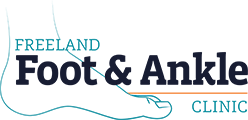 When I say "menopause," a host of symptoms likely come to your mind: hot flashes, back issues, trouble sleeping, an irregular cycle. Foot pain, though? That one is tough to plan for, and may even be a surprise when you start noticing it. There are a few reasons why menopause can cause foot pain:
When I say "menopause," a host of symptoms likely come to your mind: hot flashes, back issues, trouble sleeping, an irregular cycle. Foot pain, though? That one is tough to plan for, and may even be a surprise when you start noticing it. There are a few reasons why menopause can cause foot pain:
Menopausal women experience foot pain because of the loss of estrogen that occurs during menopause, which can cause lessened elasticity of the plantar fascia. Posture changes and bone or muscle loss may also be the culprits.
To learn why these changes happen, how to manage the symptoms, and what tangible steps you can take to decrease your discomfort, keep reading.
What is Menopause?
Kimberly Peacock, Karen Carlson, and Kari M. Ketvertis' article Menopause, published by StatPearls and available on the National Library of Medicine, explains that menopause is normal, affecting menstruating females aged 40-45 and involves the permanent cessation of the menstrual cycle. Your body no longer produces reproductive hormones like estrogen, and a number of changes occur as a result.
Menopause can also affect those who have gone through surgical removal of ovaries, received treatment for endometriosis, cancer chemotherapy and radiation, and those who suffer from certain chronic illnesses. "Natural menopause" is the term for menopause that occurs because of nonpathological estrogen deficiency, or estrogen deficiency not caused by an external illness, disease, or disorder.
Why Does Menopause Cause Foot Pain?
As I said above, menopausal women often complain of an increase in general pain, including foot pain, because of the loss of estrogen, which affects collagen production and, as a result, elasticity. Foot pain in women over 40 may be caused by plantar fasciitis, bone loss, and posture changes.
Plantar Fasciitis
Plantar fasciitis is the most common cause of heel pain. This condition develops when the fibrous band of tissue running along the bottom of the foot, also known as the plantar fascia, sustains small tears. It is common for plantar fasciitis sufferers to experience severe pain following sleep or extended rest periods. Because the loss of estrogen leads to a possible decrease in collagen production, that thick, fibrous band of tissue becomes even less elastic. As a result, those small tears are more prevalent.
How to Treat Plantar Fasciitis for Women over 40![SHoe insert new balance]()
If you're dealing with heel or foot pain, the following options are available to get you back on your feet with less pain and no surgery:
- Supportive Shoes: Use your heel pain as a well-earned excuse to go shoe shopping! You don't necessarily have to give up high heels as long as the flat shoes you wear offer plenty of support.
- Taping and Splinting: using tape and a high-quality stretching splint can also help support your feet and allow for the appropriate stretch in the connective tissues.
- Prefabricated Insoles: We recommend Pure Strides are over-the-counter insoles to give you even more everyday support.
- Custom Orthotics: Typically covered by commercial insurance plans, custom orthotics offer unmatched structural support. Many patients see exponential improvement following a brief break-in period. These devices are even billable through your insurance!
- Laser Pain Therapy: By targeting specific trigger points, the laser treatment improves circulation to the damaged areas. This helps encourage your body's natural healing response and can help shorten recovery time.
- EPAT: Short for Extracorporeal Pulse Activation Technology, this treatment aggravates the cells in the painful area, activating blood flow, oxygen, and healing factors that encourage cellular repair.
Suppose these options are exhausted, and you are still experiencing pain, inflammation, or discomfort. In that case, we can order advanced imaging (an MRI or CT) or provide you with a referral to a trusted physical therapist.
Bone Loss
As we age, both males and females may experience osteoporosis, arthritis, and other conditions that lead to a general weakening of the bones in our bodies. For women, this bone loss may start sooner and progress more quickly. There is a five-step process that occurs when our bones regenerate, and menopause may have negative effects on this process. There is a lot of science involving osteoclast resorption and osteoblast production that the article I mentioned above goes into. The lowdown? More bone is being resorbed than is being created, and that leads to bone loss.
How to Prevent & Manage Bone Loss for Women over 40
Preventing bone loss before menopause can be a great option for some. If you are in your early twenties or thirties, you may think of menopause as something to deal with down the line, but small habit changes now can lead to less bone loss later. Strength training is one way to lessen bone and muscle loss as we age. Lift heavy and lift often! Don't be afraid of "getting bulky" because recreational weight lifting will likely not lead to you gaining any significant bulk. On top of that, the muscles we build when we're young are the muscles that help us function as we age. Do squats so you can get off the couch on your own. Do deadlifts so you can bend over and pick up your grandchildren. Do bicep curls so you can carry groceries into the house and put them away independently.
If you're struggling with bone loss during menopause now, supplements and adjustments to your diet can help slow that process down. You unfortunately can't gain back any bone you lose, but you can avoid more loss. Eat a diet high in protein and healthy fats, supplement collagen, and ask your family doctor about other vitamins, like C and D, that you can take.
![menopause yoga]() Posture Changes
Posture Changes
According to the article cited above, "The North American Menopause Society stated women gained an average of 5 pounds (2 kg) over the menopause transitional period. Additionally, a decrease in height may be noted, associated with osteoporosis." Changes in the composition of your body lead to changes in your posture; changes that will likely affect your feet. When your posture suffers, your body overcompensates. Here are some tips to counteract that.
How to Deal With Posture for Women over 40
Practice regular stretching. A good morning and evening stretching routine can make a world of difference in your posture and general mobility. Here is a little yoga for the feet to get you started. Yoga and Pilates can be very helpful when it comes to improving posture. Staying active overall will also go a long way in helping your posture. A bonus? Regular activity, even an evening walk once a day, will do wonders to boost your mood.
No matter what stage of life you are in, Freeland Foot and Ankle is here to help! Whether you're struggling with heel pain, fungal toenails, warts, or any other foot-related ailment, we are the podiatry specialist for you! By focusing on conservative treatments before considering surgery, we get you back on your feet and back to life in no time. Call or text us at 989-695-6788 to make an appointment today!


 Posture Changes
Posture Changes